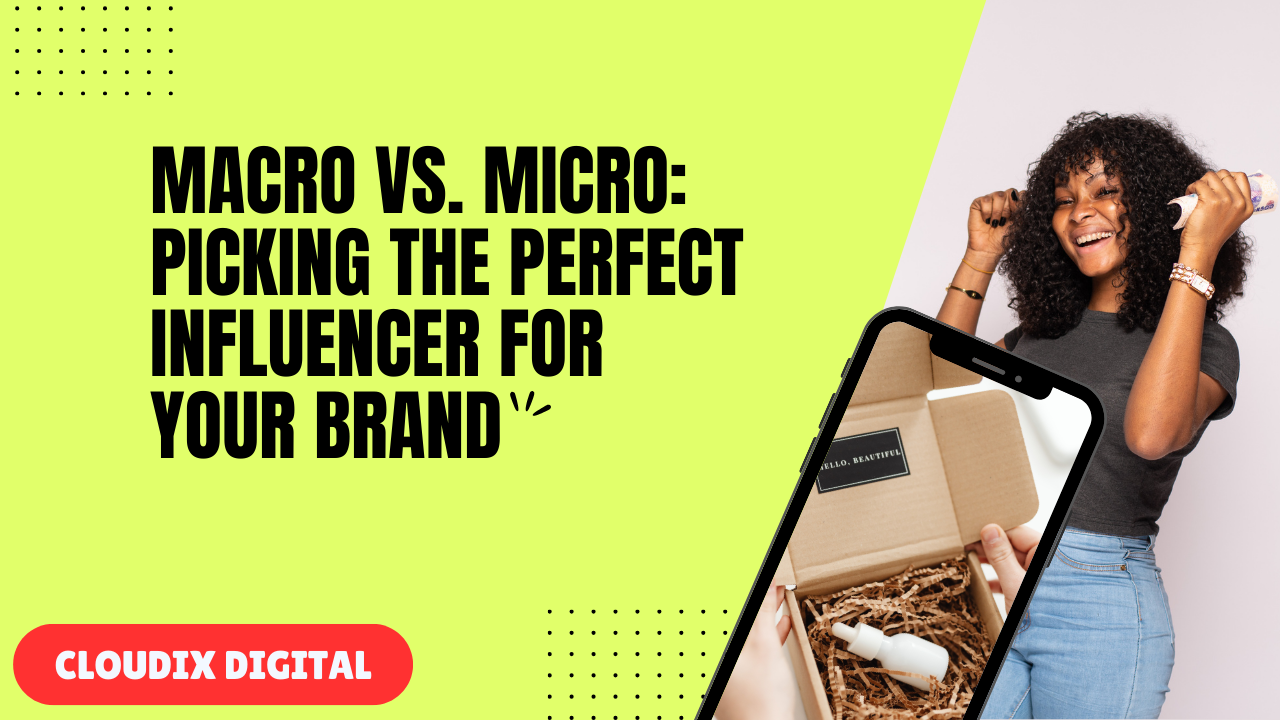
In the dynamic world of digital marketing, influencers have become game-changers for brands. Understanding the difference between macro and micro influencers is crucial in making informed decisions for your brand’s success. This comprehensive guide will walk you through the basics, helping you navigate the influencer marketing landscape and choose the perfect influencer to elevate your brand. Get ready to dive into the macro vs. micro debate.
Defining Macro and Micro Influencers:
Before delving into the selection process, let’s define macro and micro influencers. Macro influencers typically have a massive following, often reaching hundreds of thousands or even millions. These influencers, often celebrities or well-known personalities, offer broad reach but may come with a hefty price tag.
On the other hand, micro influencers have a more modest following, typically ranging from a few thousand to a hundred thousand. Despite their smaller audience, micro influencers often boast higher engagement rates and niche-specific audiences, making them an attractive option for brands with a targeted focus.
Setting Your Influencer Marketing Goals:
Begin by outlining your influencer marketing goals. Whether it’s increasing brand awareness, driving sales, or promoting a specific product, clarifying your objectives will guide your influencer selection process. Macro influencers may be ideal for broad reach and visibility, while micro influencers excel in creating authentic connections with a specific audience.
Consider factors like audience demographics, engagement rates, and the influencer’s ability to align with your brand’s values. A micro influencer with a dedicated and engaged following may deliver more impactful results for niche markets compared to a macro influencer with a broader, less targeted audience.
Evaluating Macro Influencers:
When considering macro influencers, focus on their reach and celebrity status. Analyze their follower demographics and ensure they align with your target audience. Evaluate their previous collaborations and the success of those campaigns. While macro influencers can offer extensive exposure, be mindful of potential challenges such as high costs and potential lack of authenticity.
Negotiate transparent terms, ensuring that the influencer’s content resonates with your brand’s identity. Leverage macro influencers for major product launches, brand announcements, or when widespread visibility is crucial to your marketing strategy.
Exploring the Power of Micro Influencers:
Micro influencers bring a different set of advantages to the table. Their smaller, more engaged audience often leads to higher trust and authenticity. Micro influencers are adept at creating genuine connections, making them valuable for brands seeking a more personalized approach.
Look for micro influencers whose niche aligns with your brand. Investigate their engagement rates and the quality of their interactions with followers. While micro influencers may not have the same reach as their macro counterparts, their ability to foster meaningful connections can result in more impactful and authentic brand collaborations.
Budget Considerations:
Budget plays a significant role in the macro vs. micro decision. Macro influencers typically demand higher fees due to their extensive reach and popularity. Consider your marketing budget and weigh the potential return on investment. Micro influencers may offer a cost-effective alternative, allowing you to collaborate with multiple influencers within the same budget.
Keep in mind that effective negotiation is key. Macro influencers may be open to negotiation, especially if they see value in a long-term partnership. Micro influencers, eager to build their portfolios, may also be flexible in terms of compensation.

Measuring Success: Tracking Metrics and KPIs:
Regardless of your influencer choice, tracking performance is essential. Define key performance indicators (KPIs) based on your goals—whether it’s website traffic, engagement rates, or conversions. Use tools like Google Analytics and social media analytics to monitor the impact of influencer collaborations.
Regularly evaluate the success of your influencer campaigns and adjust your strategy accordingly. A macro influencer may drive immediate visibility, while a micro influencer’s impact may take time to manifest. Be patient, and use data to inform future collaborations and continuously refine your influencer marketing strategy.
Navigating the macro vs. micro influencer landscape is a pivotal decision in your brand’s marketing journey. Understanding the strengths of each and aligning them with your goals ensures a strategic approach to influencer marketing success. Whether you opt for the broad reach of macro influencers or the authentic connections forged by micro influencers, the key lies in finding the perfect fit for your brand. Make data-driven decisions, stay flexible in your approach, and watch your brand flourish in the dynamic world of influencer marketing.
By grasping the fundamentals outlined in this guide, you’ll establish a solid foundation in the realm of influencer marketing. Cloudix Digital is dedicated to assisting beginners on this enlightening journey. Eager to unleash the power of influencer marketing? Keep an eye out for additional advice, strategies, and insights from our experts to elevate your brand.
Keep in mind, expertise empowers progress, and with Cloudix Digital’s support, you’re well on your way to becoming a proficient influencer marketing enthusiast. Embrace the learning process and online triumph!
Connect with us today to explore how we can enhance your influencer marketing endeavors and propel success for your brand.
Know more about us on:





